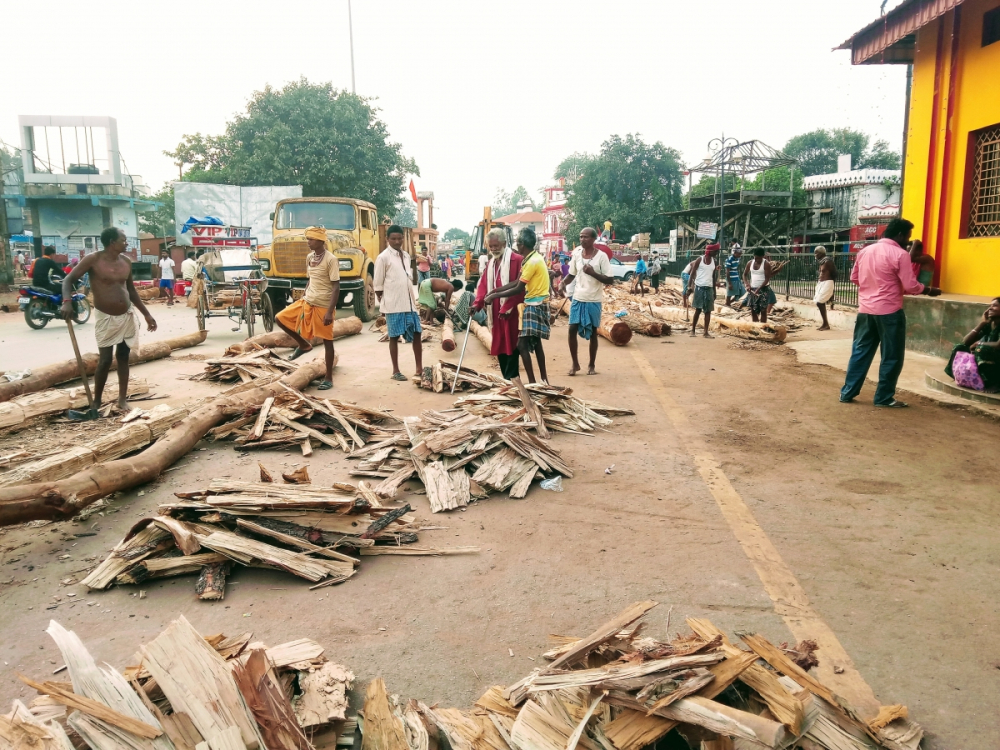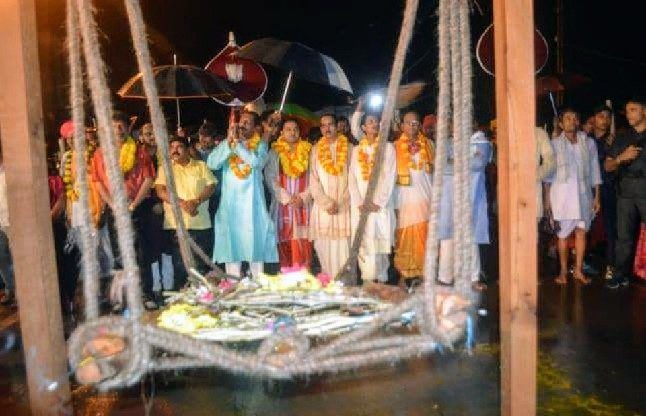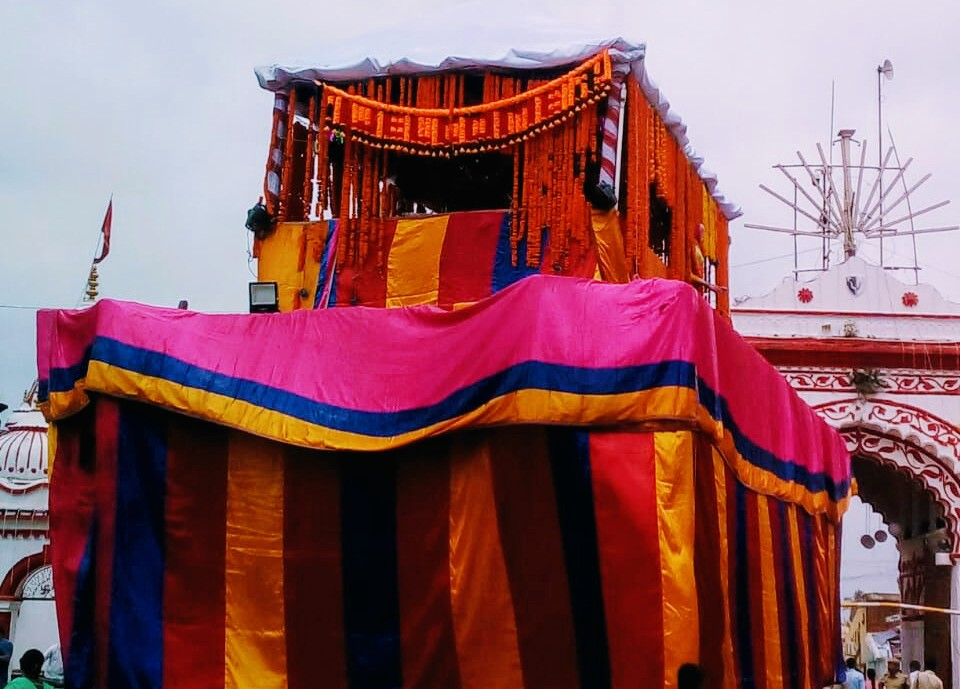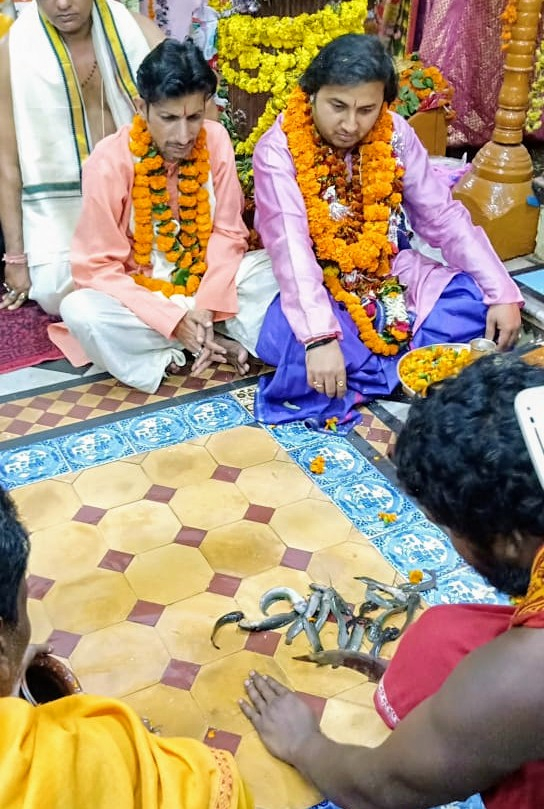Dussehra in Bastar is a unique ritual as it is celebrated with extensive rigor for a period of seventy-five days during the month of ‘ashwin’ according to the Hindu calendar. It is a mesmerising event, celebrated earlier in year in a milder form during the month of ‘chaith’ (according to the Hindu calendar). The Dussehra of Bastar does not celebrate the killing of Ravana, rather it is a ritual of the goddess Danteshwari and other local deities who come together in a congregation.
Telling the Tale of Bastar Dussehra
In most accounts, the Bastar Dussehra is believed to be a six hundred years old festivity. It was started by Maharaja Purushottam Dev in the 15th century (1408 A.D). Some accounts trace the beginnings of Bastar Dussehra Mahotsav in the 13th century, in Bade Dongar, the capital of Kakatiya/Chalukya rulers of the area. Maharaja Purushotam Deo of the Kakatiya clan, a devotee of Jagannath of Puri, walked to Puri laden with gifts and gold and reached the Jagannath temple after a year’s travel, where he made his offerings. The story goes that Lord Jagannath directed his priest to title the king ‘rath pati’ or the head of the chariot, and to gift him with a rath or the sacred chariot used in the festival of chariots or rath yatra in Puri. Following this the priest gifted the king a mammoth wooden chariot with sixteen wheels.
The king and the followers found it excessively difficult to travel in this gigantic chariot and therefore, it was broken into three part so that two chariots with eight and four wheels were taken back. The third chariot with four wheels was left behind. According to another narrative, the chariot was broken into two parts; one with twelve wheels, the other with four wheels and both were taken by the king to Bade Dongar. Once the king reached his capital, chariots became an important part of Dussehra. The royal state also after this visit started celebrating the Goncha festival.
Till the seventeenth century, Dussehra was celebrated in Bade Dongar. It was during Maharaja Dalpat Deo’s kingship (1721-1775) that Bastar’s capital shifted to Jagdalpur or what was then called Jagtuguda. Jagdalpur was home to the Jagtu Mahara clan in the seventeenth century, which is why the place was called Jagtuguda. Jagtu Mahara, a ‘lower’ caste community requested Maharaja Dalpat Deo to help them save the wild animals in the forest. When Maharaja Dalpat Deo visited Jagtuguda he could not go back, and made Jagtuguda the capital of Bastar. Maharaja Dalpat Deo then named the place Jag-dal-pur; and the grand festival of Dussehra was also brought to Jagdalpur.
Chaitrai or Chota Dussehra
Dussehra is celebrated twice in a year in Bastar. The first Dussehra of the year (celebrated during summers) was called Chaitrai Dussehra or Chota Dussehra which has now lost its essence. This festival was celebrated for fifteen days i.e. the first fifteen days of the month of chaith. On the first day of this month an earthen pot was worshiped and believed to be the abode of the goddess for the coming eight days. While the first eight days were devoted to the worship of the goddess, from the ninth to the twelfth day of this month the rath or the wooden chariot (with idols of Ram, Sita and Laxman from the Jagannath temple of Jagdalpur seated inside) was taken around the city in revelry. The sacred chariot was about eight-feet-high, had four wheels and was beautifully decorated with satin cloth and marigold flowers. Many from the villages around were invited to pull the chariot and take it around the city, assisted by devotees. As the chariot was pulled, the city echoed with praises of the goddesses and the sound of shankhs and ghantas.
On the other hand, in the villages, nature was worshiped and so was the spiritual essence of the soil. This festival in the villages was celebrated till the twelfth day of the month. On the thirteenth day devotees from different villages nearby, having received an invitation, carried their gods and goddesses to Jagdalpur to participate in the ritual called ‘aamanvakhani’. The dang, bairak, tarash, doli, anga and chatra they carried were welcomed with dhol-nagade, tudbudi, mohri, ghanta and shankh. On this day, goddess Danteshwari in Jagdalpur was offered the new mango fruit which the king and the people would later share.
On the fourteenth day of this month at mid-night ‘nisha-yatra’ or a devotional procession was taken from the Danteshwari Temple to the Itwari bazaar puja pandal in Jagdalpur; where the goddess was worshiped and animal sacrifices were made. On the fifteen day which is the day of new moon or amavasya, Mavli goddess of Dantewada was welcomed and carried on the shoulders of members of the royal family and the royal priests. Finally, on the sixteenth day ‘auhadi’ or the farewell rituals were initiated. On this day all the gods and goddesses from the villages would leave for their return journeys. On the seventeenth day, goddess Mavli and her devotees would also set for their journey to Dantewada.
Bastar ka Dussehra
Pre-festive Arrangements
The grand level at which the festival is celebrated demands extensive preparations before the event takes its form and rigor. Months before the festive season starts, the royal family, the temple committee and the district level officers come together to make this event possible. In earlier times the heads of several parganas (which is made of a few villages) called Manjhi collectively represented the tehsil or the block. The Manjhis would collect rice, varieties of pulses, salt, turmeric, oil, animals for sacrifice etc. calling it ‘dussehra bokda mangni chaur’ as also monetary donations which they called ‘bisaha paisa’. Men and women of all castes, classes and religion are said to have extended their support for the festival to take place. The cereals and raw materials for food were collected in the royal warehouse. Several employees from the village (especially an accountant) were hired by the royal warehouse before Dussehra for book-keeping. Even today this ritual remains, although its form and nature has changed with time. Now a working committee made up of the Adivasi leaders, priests of Danteshwari temple, MPs, MLAs, other members of the ruling party etc. come together to lead the Dussehra arrangements. The festival is aided by the state government. This working committee starts functioning by September every year.
Most villages and parganas have their contribution decided; without which the festival remains incomplete. The woods for the chariot are brought by people of Agarwara, Kachorapati and Raikera pargana. The carpenters and blacksmiths from Jhad Umargaon and Beda Umargaon make the chariot. The Kachindevi ritual is taken care of by the ‘ lower’ caste family of Anchal. The jogi comes from a certain lineage in the villages Aamabal and Parali. The rope that pulls the chariot is made by people from Karanji, Kesarpal and Sonabal village. Married women of the Kenwata and Panara barber communities worship and make offering to the chariots before it starts its journey. The chariot with four wheels is pulled by people from the Kachorapati and Agarwara pargana. The chariot with eight wheels is pulled by a tribe of Kilepal. Nine young men from the Bhatra community play an important role in Bhitar Raini and Bahar Raini rituals. People of Gadeya village are the ones who carry and place the ladder for the chariot.
The Pat-Jatra Ritual
Bastar Dussehra starts with the ‘Pat Jatra puja’. This event is a ritual where the forest and the woods are worshiped and given their due. It is celebrated on the day of the new moon. Bastar Dussehra starts with this ritual because the life of most Bastariyas or they who live in Bastar is carved by the woods. Their life has rather depended most on the forests and its gift of the woods to them. This event is an emblem of the Adivasi life-worlds. The chariot is only made of Sal and Tinsa wood. The wheels of the chariot are made of Tinsa wood and the body is made of Sal wood. On this day of the new moon, traditionally timber wood from a Sal tree is brought from the Machkot forest or the Bilori forest.

Figure 1: Wood for the Chariot
This piece of wood called Thurrule Kotla is worshiped and in the process offered sacrifices. It is believed ‘what’ is to be sacrificed has moved from humans to animals to vegetables today. This ritual demands a sacrifice of mangur or mongri (in the local language) fish also called the Walking Catfish. In the year 2018, people from the village Jhara Mormon and Bedoumargaon brought the wood from Bilori forest. The wood and tools for construction brought from Bilori were placed in front the blue and white Rajmahal. During the ritual on 11th August, 2018 five Mangur fish, one egg and one goat was sacrificed. The ritual ends when the making of the chariot starts and a nail is hammered into the wood.

Figure 2: The Sacred Chariot in Making
Deri Gadhai Ritual
The Deri Gadhai ritual performed on 22nd September, 2018 is the second ritual in the Bastar Dussehra calendar. It may also be called the symbol of beginning of an auspicious journey.
As part of the ritual, people of the village Biringpal bring two Sal logs that are ten feet in height. They are finally taken to the Sirhsar Bhawan near the Raj Mahal. It is in the Sirhsar Bhawan that the logs are placed and worshiped. The logs are placed at a distance of fifteen to twenty feet and worshiped with haldi (turmeric), chandan (sandal) and kumkum paste. Later a white cloth is tied to the logs. In the process, Mangur fish and an egg is placed along with flowers and puffed rice (lai) close to the log. It is the responsibility of the royal family to arrange Mangur fish for the sacrifice. After Deri Gadhai, wood from the forests and carpenters from several villages slowly start reaching the Sirhsar Bhawan. Much of the responsibility of making the wooden chariot is that of men from Bedaumar gaon.
Kachingadi Ritual
When the capital of Bastar was shifted from Bada Dongar to Jagtuguda/Jagdalpur, the city that hosted Bastar Dussehra also moved. Since then, every year a day before Navratra (worship of the goddess) would start, the clan goddess Kachindevi of the Mahra (harijan) community is asked for her blessings and approval to celebrate Dussehra in her city. On this day the Maharaja travels to the temple of goddess Kachindevi (located on the road to Pathraguda). It is believed that the goddess herself comes to bless the event.

Figure 3: The Handcrafted Hammock of Bell Thorn
A hammock of bell thorns is handcrafted for the goddess.

Figure 4: The Hammock of Bell Thorn for the Child Possessed by Kachin Devi
A female child from the Mirgan community is believed to be possessed by the goddess. Once the child is possessed she is made to lie down on the hammock of bell thorns.

Figure 5: The Royal Family Waiting for the Goddess Kachin Devi

Figure 6: The Royal Family Praying to Goddess Kachin Devi
She is then worshiped and requested to allow them to celebrate Dussehra in Jagdalpur.
Kalash Sthapana and Jogi Baithai
On the first day of Navratri (which is the first day of the month ashwin according to the Hindu calendar) the kalash sthapana is done i.e. an urn is worshiped and considered to be the abode of the goddess. From this day the Danteshwari temple of Jagdalpur plays a very important role.

Figure 7: Devotees with Angas Going to the Temple

Figure 8: During the Festival Many are Possessed by the Gods and Goddesses
It welcomes thousands of devotees. Many of these devotees get jyoti kalash sthapana in the name of their family and loved ones; this is a paid process where charges for ghee and jyoti is twelve hundred and one rupee whereas, for oil and jyoti it is six hundred and one rupee. This year Danteshwari temple of Jagdalpur hosted five thousand five hundred kalash sthapanas.
On the same day, another ritual called ‘Jogi baithai’ takes place. The members of a certain lineage of Halda caste from the villages of Aamabal and Parali become the jogi.

Figure 9: Musical Procession Walking towards Sirasar Bhawan for Jogi Bithai
This ritual takes place in the Sirasar Bhavan. At the centre of the Bhawan, a two to three feet deep square pit has been constructed for the jogi to sit in meditation. The Maharaja himself comes to initiate this ritual and be a part of this ceremony. While the ritual is performed, seven Mangur fish are sacrificed. This tradition was initiated by a devotee a few decades earlier. He meditated and fasted through the nine days of Navratri such that the festival of Dussehra was celebrated without any obstacles or bad omens. Since, then the tradition has been followed every year. During these nine days neither does the jogi eat or drink nor does he urinate or defecate. On the ninth day of the month of ashwin which is the last day of Navratri, is when the jogi ends his fast. He is then worshiped again and honoured with several gifts.
The Sacred Chariot
The holy chariot is believed to have had sixteen wheels in the early years. Slowly the growing cities, inconvenience and inability faced by the people who pulled it urged for a smaller chariot. The two chariots today have eight and four wheels.

Figure 10: The Old Chariot with Four Wheels
The old holy chariot with four wheels takes rounds in the city from the second to the seventh (saptami) day of the month of ashwin. It travels a certain path every day and finally, returns to the gates of the Rajmahal. This chariot is decorated with flowers and is thus, called the flower chariot. The Maharaja on this chariot is gifted with a floral head gear. On seventh day of the month of ashwin the chariot takes its last round. After maha-ashtami and navmi (eighth and ninth day of month of ashwin) is celebrated in Jagdalpur, on the tenth day the newly constructed chariot with eight wheels is ready to start its devotional journey.
Nisha Jatra Ritual
The nisha jatra ritual is performed on the eighth day of the month of ashwin. On this day, the chariot does not take its rounds, rather several offerings are made to the goddess at mid-night. As astami ends and navmi starts, the auspicious time to make the sacrifices arrives.

Figure 11: The Procession Walk for the Rituals to be Performed During Nisha Jatra
Nisha jatra is the procession of the night that stops at the nisha jatra temple or puja mandap near Itwari Bazar in Jagdalpur. The goddess is offered eleven male goats, Mangur fish and varieties of pumpkin to make her happy. Two male goats are sacrificed at the Mavli temple, two at the Singh dwar in the Rajmahal and one in the temple of goddess Kali.

Figure 12: Goddess Danteshwari of Jagdalpur
The Danteshwari goddess is offered a black pigeon and seven Mangur fish. Through these offerings the royal family and the priests pray to the goddess to save Bastar and its people from bad omens. The tradition of such sacrifices is presumed to have started in the fourteenth century. These offerings were made to keep the royal state safe from bad omens and spirits. In early times thousands of buffaloes as well as men were offered to please the goddess. As the time has changed so have the rituals. The nisha jatra ritual is now performed to maintain peace in Bastar.
Mavli Parghav
On the ninth day of the ritual, after all ceremonies around Navaratri are over, goddesses from Dantewada and other villages come to Jagdalpur to enhance the spiritual essence of the event. In the morning, traditionally, young girls are worshiped as the representatives of goddesses on earth; they are offered food and gifts. In the evening, the jogi breaks his yog and is honoured with gifts.

Figure 13: Goddess Mavli

Figure 14: Goddess Mavli in the Doli and Goddess Danteshwari's Chatra
Finally, at night, goddess Mavli (goddess Danteshwari’s sister) reaches Jagdalpur in goddess Danteshwari’s doli and along with that arrives goddess Danteshwari’s chatra (a symbol of the goddess that can be worshiped). The idol of goddess Mavli is created by a new cloth painted with sandalwood paste and is covered with flowers.

Figure 15: Pumpkin Sacrifice During the Ritual of Mavli Parghav

Figure 16: Sacrifice of Mangur Fish During the Ritual of Mavli Parghav
The two goddesses and many other deities from villages in Bastar are welcomed by the royal family, the royal priest and the royal teacher.

Figure 17: Local Entertainer at the Temple
The celebration is enhanced as people dance to the melody of several musical instruments.
Bhitar Raini-Bahar Raini
On the tenth day (Vijayadashami) of the month of ashwin, Jagdalpur welcomes its highest number of devotees. The newly constructed chariot (with eight wheels) with goddess Danteshwari’s chatra in it is taken around the city. Once the holy chariot returns to the gates of the Rajmahal, it is ready to be stolen. This tradition brings two stories to us. The first story is about a year when the temple committee forgot to invite an Adivasi tribe of Kilepal. In response, to having been left out, they robbed the chariot and took it to the forests of Kumhdakot. Another story states that when the royal family and Jagdalpur celebrated Dussehra, Navakhani (a festival celebrating the new crop) was celebrated in the villages. The Adivasi tribes thus, took away the chariot to kumhdakot where they could celebrate Navakhani with their king. In this light on the night of Vijayadashami the chariot is taken away by the Adivasis. In the year 2018, the chariot was taken away by four thousand people of fifty-five villages from Kilepal, Gadhiya and Karekot pargana. The chariot was followed by four hundred and eighty-six local gods and goddesses. The next day, the king and his followers go to Kumhdakot for a negotiation with the Adivasis. He is offered the new crop cooked in the form of kheer (rice cooked in sugar, milk and water). Once this ritual is over, the chariot is taken back to the gates of the Rajmahal. The ritual of taking the chariot to Kumhdakot is called bhitar raini and the ritual of bringing the chariot back to Jagdalpur is called bahar raini.
Muriya Darbar
On the twelfth day of the month of ashwin, the ritual Kachin-jatra is performed in the first half. Kachindevi is worshiped and thanked for her blessings. After this ritual, Muriya Darbar is arranged at the Sirasar Bhawan. Muriya Darbar is a one hundred and two year old event. The Manjhi (or leaders of different villages) and other representatives from the villages came together to present their issues to the king and their elected representatives. The chief minister of Chhattisgarh has ensured his presence in the Muriya Darbar since last eight years. The first Muriya Darbar was held on 8th March, 1876 when the authorities had honoured the Manjhis to bring together an event as grand as the Dussehra. Since then, this event became an integral part of the functions. Approximately Manjhis from eighty parganas would attend this event to let the king know about the problems they faced in the village and in the processes of administration; as also the king shared with them the new agendas and laws of the kingship. The death of Maharaja Pravir Chandra Bhanjdeo had led to an absence of the royal family in the Muriya Darbar. Very recently in 2015 Maharaja Kamal Chandra Bhanjdeo has again started attending the Muriya Darbar.
Auhadi: Kutumb Jatra and Mata Danteshwari ki Vidai.

Figure 18: King Worshipping the Local Gods and Goddesses on Kutumb Jatra
The thirteenth day of the month of ashwin, is when all the gods and goddesses from around the city are worshiped and given a farewell. On this day more than twelve hundred gods and goddesses take leave from the city. The same day goddess Mavli also takes her leave. On the fourteenth day, goddess Danteshwari is worshiped and honoured with a magnificent farewell. She takes her leave as the king himself carries her on his shoulders. She travels back to Dantewada as flowers shower on her way and several devotees stand with their hands folded in prayers.
The festival ends on the fourteenth day of the month of ashwin and leaves behind a memory of coming together. A celebration of seventy-five days revives the cultural nature of the area. Despite a present where traditional know-hows are evaporating, the Bastar Dussehra focuses on a beautiful past. The festival not only represents the unity of the people in Bastar but it does highlight the significance of each community in Bastar. The event is a symbol of breaking divides among Adivasis, Harijans and the royal family itself.
This content has been created as part of a project commissioned by the Directorate of Culture and Archaeology, Government of Chhattisgarh, to document the cultural and natural heritage of the state of Chhattisgarh.












